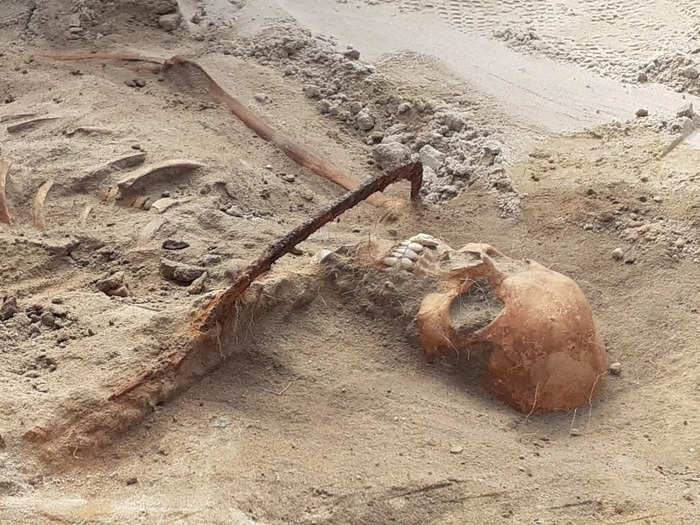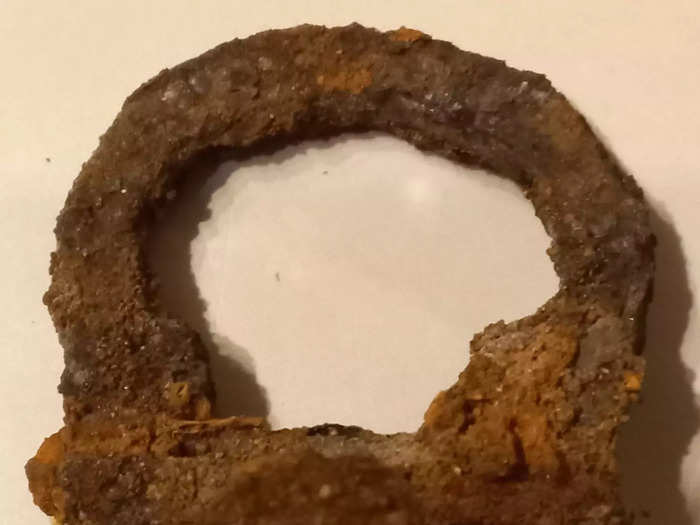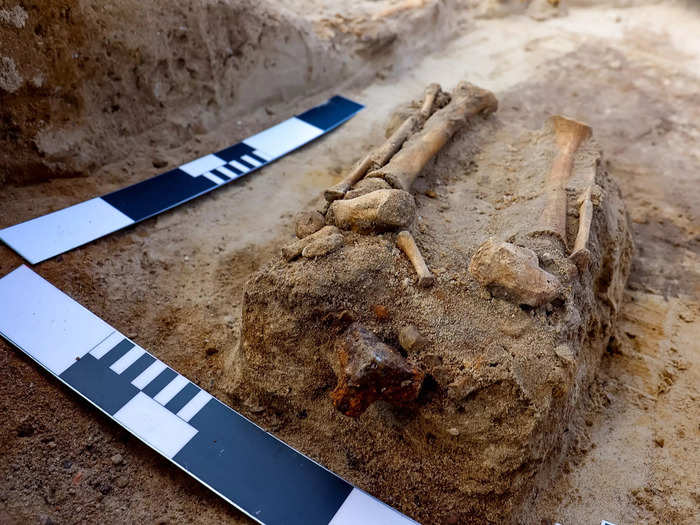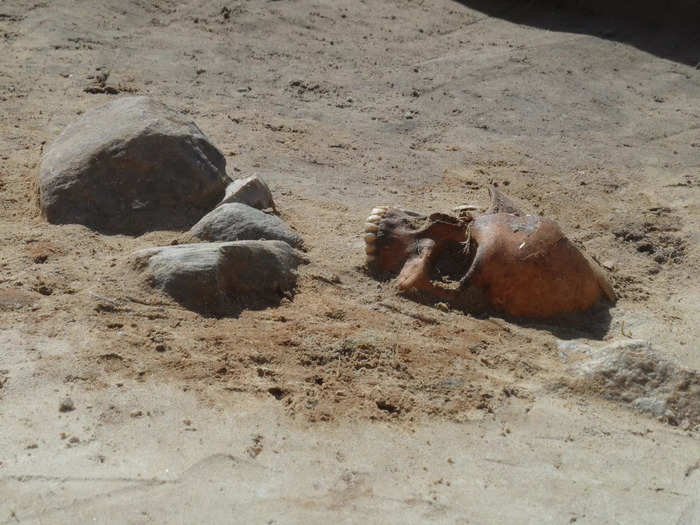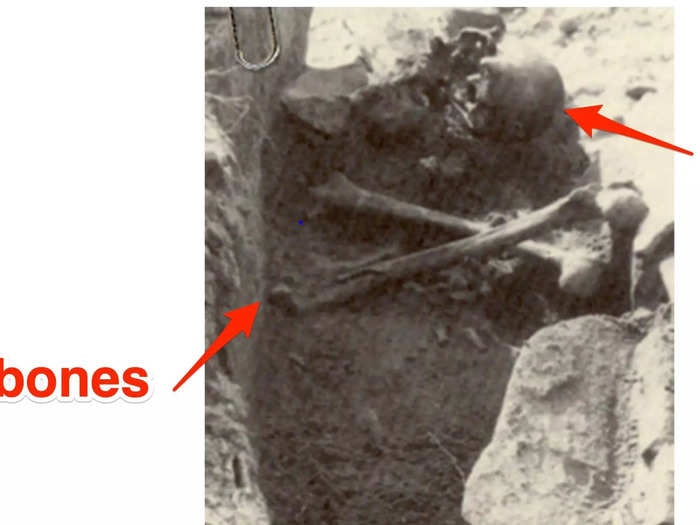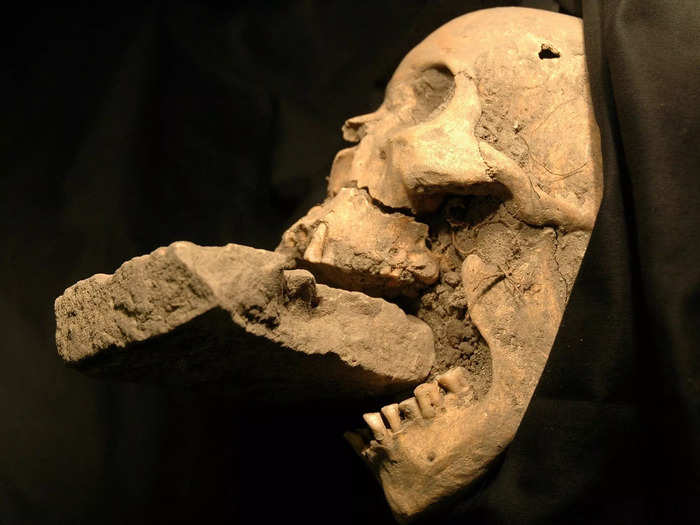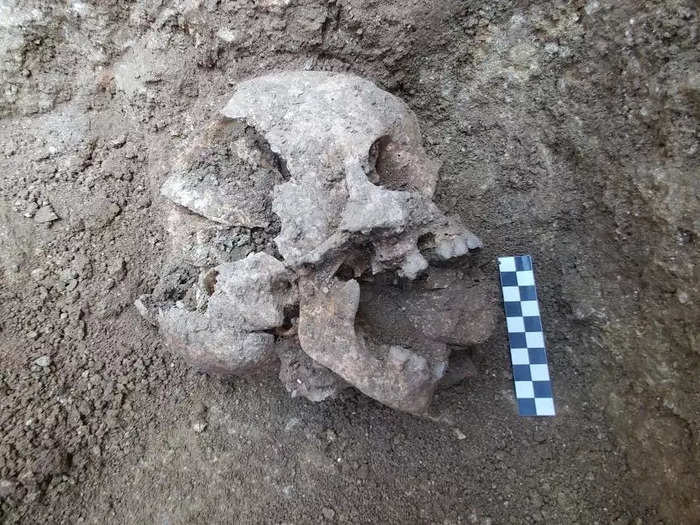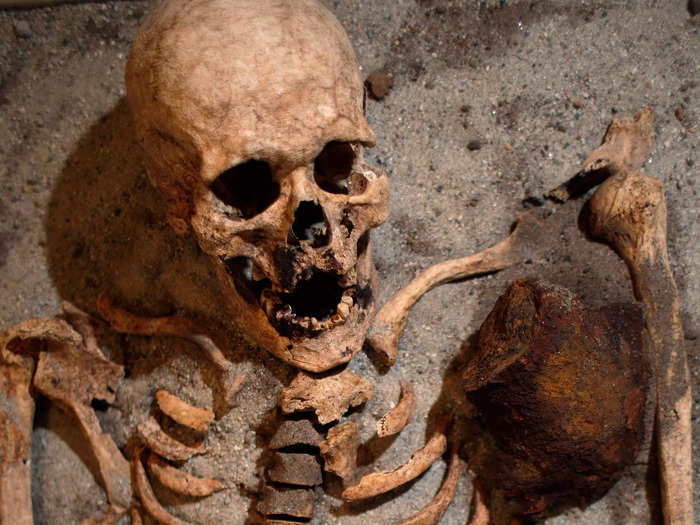Female "vampire" with protruding tooth and a sickle across her neck.Mirosław Blicharski
- Vampires have haunted nightmares for centuries, even dictating how people buried their dead.
- Archeological digs in recent years have unearthed remains of several so-called vampire burials.
They didn't resemble the blood-sucking cinematic creations of "Twilight" or "Dracula," but vampires — or at least the mythology surrounding them — have haunted people's nightmares for centuries, even dictating how villagers long ago buried their dead.
Archeological digs over the past decades have unearthed remains of several so-called vampire burials, which researchers believe showcase ancient techniques people once used to stop the dead from returning from the grave.
This practice, seen across the world, was most notable between the 14th century and the 17th century in Europe, Matteo Borrini, a forensic anthropologist at Liverpool John Moores University, told Insider last year. But unusual burial practices associated with the belief have been spotted as early as the 5th century in ancient Rome.
These "vampiric" outbreaks have been associated with times people inexplicably died in droves, for instance when epidemics such as the plague swept through an area.
The common fear was these "vampires" would hunt and kill their family members first, and then move on to neighbors and others in the village, tracking with our modern understanding of how contagious diseases spread, Borrini told Insider.
Whether or not a unique burial technique is necessarily tied to "vampirism" per se can be a matter of debate among experts, Borrini said. Still, they are generally thought to have been motivated by superstitions or folklore that lead people to believe the dead could haunt the living.
These are nine techniques researchers have posited were meant to keep "vampires" in their graves for good.
Sickles were placed across their throat
Female "vampire" with a sickle across her throat found in Pień, Poland. Mirosław Blicharski
In 2022, an archeological team discovered the remains of a female "vampire" in a 17th-century Polish cemetery where she was buried with a sickle laid across her neck, ostensibly to keep the woman from rising from the dead.
The sickle was placed over the woman's neck in such a way that if she had tried to get up, her head would have been cut off or injured, archaeologist Dariusz Poliński from Nicolaus Copernicus University in Poland, who led the dig, told the Daily Mail last year.
But it's also possible the sickle represented something else entirely, Borrini told Insider at the time. A 2015 paper investigating remains buried in Poland alongside sickles posited the tools, commonly used in agriculture, could be a sign of social status.
Triangular padlocks were used on feet and toes
Triangular padlocks were attached to people’s feet to keep them tethered to the ground once buried, Poliński said. Magdalena Zagrodzka
Poliński and his research team recently uncovered more graves at the same site as the female "vampire" discovered last year, including a 5- to 7-year-old child unearthed in the same cemetery this year. Several of these remains, including the woman buried under a sickle, had mysterious triangular padlocks placed on their feet, another sign of a "deviant" burial.
The triangular padlocks were meant to tether the dead to the ground, Poliński told Insider.
Bodies were buried face down
Archeologists discovered the skeletal remains of what they believe to be a 17th-century "vampire child" in an unmarked Polish cemetery. Łukasz Czyżewski
Poliński said he and his researchers have uncovered about 100 graves in the Polish "necropolis." He believes it was a makeshift graveyard for "the excluded" — likely those who were not welcome in Christian cemeteries — notably because the site was not marked on any maps.
Another bizarre burial practice documented at the site was the placement of the body itself.
Some of the remains were placed faced down in the grave.
Stones were used to weigh the bodies down
Archeologists also found a collection of loose bones near the child's gravesite, as well as a pregnant woman. Magdalena Zagrodzka
Another unusual burial technique found at the site was that some of the remains were loaded with stones.
In some cases, these stones seemed to be "intentionally placed" across the throats or forearms. Stone also weighed down a unique grave containing the remains of a pregnant woman, Poliński told Insider.
The team is still working on understanding what these findings mean, he told Insider.
But this isn't the first time stones have been linked to "deviant" burials. Borrini previously told Insider weighing remains down with stones is one noted way people may have tried to keep the deceased's spirit in the grave.
One "vampire" in Connecticut was found with its skull and thighbones arranged on top of its ribs
An annotated picture shows the placement of the "Connecticut vampire" skull and bones in the grave. Daniels-Higgenbotham, J. et al. 2019, Genes 2019, 10(9), 636; https://doi.org/10.3390/genes10090636; Insider
Scientists have long been fascinated by the case of John Barber, a 55-year-old American man who was buried in Connecticut in the 1800s under unusual circumstances.
When his remains were uncovered by archeologists in the 90s, he had been decapitated and his skull and thigh bones had been placed across his rib cage.
Scientists believe the tactic was used to keep Barber from rising from the dead and walking around to attack the living.
Barber died of tuberculosis, which is accompanied by heavy weight loss, graying skin, and coughing up blood — symptoms other villagers may have interpreted as vampirism, according to analysis completed by Connecticut archeologists.
Not everybody agrees this burial is a bona fide "vampire" gravesite, though. Borrini recently told Insider that for him, vampire belief revolves around rearranging a body while it's still decomposing, while this body would have had to be moved when it was already a skeleton.
Still, this bizarre occurrence is likely to be linked at least to superstition or folklore about the way disease spread through dead bodies at the time, if not vampire lore exactly.
Bodies were sometimes exhumed and burned
Barber's post-mortem fate may have coincided with a "vampire panic" that swept the region in the late 1800s.
Another New England vampire scare impacted a family in Connecticut that came to be known as the "Jewett City vampires."
In 1894, several members of the Ray family died of consumption, now known as tuberculosis.
The Rays decided they needed to keep their deceased relatives from coming back to life and killing their living family members, state Archaeologist Nicholas Bellantoni and municipal historian Mary Deveau said in a 2008 tour covered by local news outlet The Register Citizen.
The family chose to exhume two of the sons who had died from the disease and burn them "on the spot," according to newspaper reports that recounted the event eight years after it happened, per the Register Citizen.
Bricks or stones were placed in their mouths to prevent the dead from chewing their way out of the ground
Italian researchers believe they found the remains of a female "vampire" from 16th-century Venice, buried with a brick in her mouth to prevent her feasting on plague victims. REUTERS/Handout
Bricks and stones weren't only used to weigh the bodies down. In some cases, these were carefully placed in the mouth of the deceased.
One such case was uncovered in Italy in 2009, when the remains of a woman from the 16th-century were found buried with a large brick jammed into her mouth. The woman was found in a mass grave and may have died from bubonic plague, which was spreading at the time.
For Borrini, who worked on the dig, this was one of the prime examples of a burial people would have done at the time for a type of vampire from European folklore, a Nachzehrer.
"It's not the classical idea that the vampire is going out and sucking the blood of people. It's more someone that is killing people from the grave before being able to then rise as a full vampire," he said.
Stones were also placed in mouths to prevent the soul from entering or leaving the body
The body of a child found in a 5th-century Italian cemetery buried with a stone in their mouth. David Pickel/Stanford University
Stones had also been used in unusual burial practices much earlier than that. That's the case of a child, about 10 years old, who died in the 5th century and was found in the ruins of an Ancient Roman villa, in Teverina, Italy.
The stone may have been a way to keep the child, who is thought to have died of malaria, from spreading the disease or generally tormenting the living.
"There's also a very ancient idea of breath being linked to life and the soul and the mouth in particular as being sort of the portal through which the soul exits after death," Jordan Wilson, a bio archaeologist and lead on the dig, told Insider last year.
"It could also have been with the intent to keep the child's body safe from witches," she said.
Stakes were placed through the heart and used to pin bodies to the ground
A skeleton pierced with a piece of iron is seen on display during a media event at the National History Museum in Sofia June 14, 2012 REUTERS/Stoyan Nenov
It was also common practice to try to pin the bodies to the ground in some way or another, Borrini told Insider last year. This can be done, for instance, by fastening the body's shroud to the coffin with nails or placing symbolic rose thorns on their graves.
But people in the middle ages in Bulgaria seem to have taken that concept one step further.
In 2012, archaeologists uncovered two bodies that were buried with iron stakes through their hearts, intended to pin them down and prevent a return from the dead.
"These skeletons stabbed with rods illustrate a practice which was common in some Bulgarian villages up until the first decade of the 20th Century," Bozhidar Dimitrov, who was head of the National History Museum in the Bulgarian capital Sofia at the time of the discovery, told the BBC.

